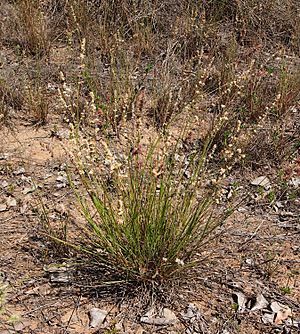Eragrostis spectabilis facts for kids
Quick facts for kids Eragrostis spectabilis |
|
|---|---|
 |
|
| Scientific classification |
Eragrostis spectabilis, also known as purple lovegrass, is a type of flowering plant that belongs to the Poaceae family, which is the grass family. This plant grows naturally from southern Canada all the way down to northeastern Mexico. It was first described in 1813 by Frederick Traugott Pursh, who called it Poa spectabilis. Later, in 1840, Ernst von Steudel moved it to the Eragrostis group.
Contents
What is Purple Lovegrass?
Purple lovegrass is a beautiful plant known for its airy, purple-tinted flowers. It's a type of perennial grass, which means it lives for more than two years. This grass is often found in open, sunny areas. It can grow in many different kinds of soil.
Where Does it Grow?
This amazing grass is native to a large part of North America. You can find it from the southern parts of Canada, through many states in the United States, and into northeastern Mexico. It likes places like:
- Open fields
- Roadsides
- Dry, sandy soils
- Woodland edges
It's quite adaptable and can grow in various environments. This wide range shows how tough and versatile purple lovegrass is.
What Does it Look Like?
Purple lovegrass is easy to spot, especially in late summer and fall. It usually grows about 1 to 3 feet (30 to 90 cm) tall. The plant forms a clump of narrow, green leaves.
Its Special Flowers
The most striking part of purple lovegrass is its flowers. They grow in a wide, open cluster called a panicle. This panicle looks very delicate and airy. When the plant blooms, these clusters turn a lovely purplish-red color. This gives the grass its common name, "purple lovegrass." The tiny seeds are also very small and are spread by the wind.
Why is it Called "Lovegrass"?
The name "lovegrass" comes from the scientific name of its genus, Eragrostis. This name combines two Greek words:
- Eros, meaning "love"
- Agrostis, meaning "grass"
Some people think the name refers to the delicate, airy look of the flower clusters. They seem to "tremble" or "dance" in the wind, which might remind someone of a loving embrace. Others believe it's because the seeds are so small and easily spread, almost like they are "lovingly" scattered everywhere.
Fun Facts About Grasses
Grasses are super important plants all over the world. Here are some cool facts:
- Grasses cover about 20% of the Earth's land area.
- Many of our most important foods come from grasses, like wheat, rice, corn, and oats.
- Grasses help prevent soil erosion with their strong root systems.
- They provide food and shelter for many animals, from tiny insects to large grazing animals.
- Some grasses, like bamboo, can grow incredibly fast!

